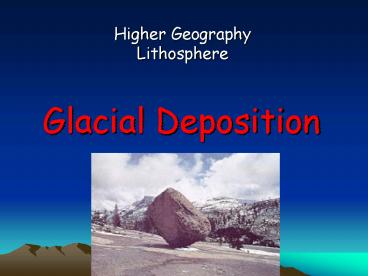Glacial Deposition - PowerPoint PPT Presentation
1 / 28
Title:
Glacial Deposition
Description:
... the major mountain or upland areas but also the great valleys and lowland plains. ... Subglacial debris moved along the floor of the valley either by ice ... – PowerPoint PPT presentation
Number of Views:140
Avg rating:3.0/5.0
Title: Glacial Deposition
1
Glacial Deposition
- Higher Geography Lithosphere
2
Introduction
- Glaciation effected not only the major mountain
or upland areas but also the great valleys and
lowland plains.
3
Deposition features include
4
Glaciers transport materials in the following
ways
- Subglacial debris moved along the floor of the
valley either by ice (as ground moraine) or by
meltwater streams under the glacier. - Englacial debris carried within the glacier
itself. - Supraglacial debris - carried on the surface of
the glacier.
5
Important
- The collective name for all the materials
(boulders, sands, gravels, clays, etc.) deposited
by glaciers is drift.
6
Drift deposits can be classified into
- Ground moraine (or till) including unsorted
materials directly deposited by ice. - Fluvioglacial materials (or outwash) including
sorted materials deposited by meltwater streams
7
(No Transcript)
8
Classification
- Features of glacial deposition
- Erratics
- Moraines (terminal, lateral, medial)
- Drumlins
- Features of fluvioglacial deposition
- Outwash plains
- Eskers
- Kames
- Kettleholes
9
Ground Moraine Landforms Resulting from Glacial
Deposition
- Higher Geography
- Lithosphere
10
Features of glacial deposition
- Erratics
- Moraines
- Drumlins
11
Erratics
- Glacially transported blocks of rock
12
(No Transcript)
13
(No Transcript)
14
Moraines
- Moraines form due to
- The dumping of debris due to ablating ice.
- The pushing of loose, ground material by the ice.
15
Types of moraine
- Terminal (or end) moraines
- Push moraines
- Lateral moraines
- Medial moraines
- Hummocky moraine?
16
Terminal (or end) Moraines
Key points
- Ice bulldozes loose soil and rock in front of it.
- All the moraine was dropped where the ice melted,
building up small ridges. - Formed from poorly sorted till that runs across
the valley at right angles to the direction of
ice flow. - Mark the maximum extent that the glacier has
advanced.
17
(No Transcript)
18
Push Moraines
- A terminal moraine marks the furthest point that
the ice has reached. - If a glacier retreats and then advances again it
may create a push moraine between the glacier and
the terminal moraine.
19
Lateral Moraines
Key points
- Develop along the edge of an advancing glacier.
- Form from debris eroded by the advancing ice and
especially from frost-shattered material loosened
from the valley sides. - When the supporting ice ablates, lateral moraines
collapse.
20
(No Transcript)
21
Medial Moraines
- Medial moraines form on active glaciers where two
lateral moraines merge when two glaciers flow
together.
22
(No Transcript)
23
(No Transcript)
24
Drumlins
- Formed in the following ways
- Melting ice deposits large amounts of moraine.
- Forward movement of the ice moulds the moraine to
form streamline mounds. - These elliptical hills are made of boulder clay,
with a steeper upstream side, are called
drumlins. - Drumlins are often found in one area as swarms.
25
(No Transcript)
26
(No Transcript)
27
(No Transcript)
28
Still Awake?

